The Energy and Carbon Footprint of an Urban Waste Collection Fleet: A Case Study in Central Italy
Abstract
:1. Introduction
2. Methodology
2.1. Background
2.2. System Boundaries
2.3. Data Analysis
3. Results and Discussion
3.1. Vehicles Not Dedicated to MSW Transport
3.2. Vehicles Dedicated to MSW Transport
3.2.1. Compactors (35–75 q) and (80–180 q)
3.2.2. Porter Vehicles
3.2.3. Compactors (180–330 q)
3.2.4. Three-Wheelers
3.3. Discussion
4. Conclusions
Supplementary Materials
Author Contributions
Funding
Acknowledgments
Conflicts of Interest
References
- Santamouris, M.; Ban-Weiss, G.; Osmond, P.; Paolini, R.; Synnefa, A.; Cartalis, C.; Muscio, A.; Zinzi, M.; Morakinyo, T.E.; Ng, E.; et al. Progress in urban greenery mitigation science—Assessment methodologies advanced technologies and impact on cities. J. Civ. Eng. Manag. 2018, 24, 638–671. [Google Scholar] [CrossRef] [Green Version]
- ISPRA—Istituto Superiore per la Protezione e la Ricerca Ambientale. Rapporto Rifiuti Urbani. Edizione 2019; ISPRA—Istituto Superiore per la Protezione e la Ricerca Ambientale: Rome, Italy, 2019.
- EU Commission. Directive 2008/98/EC of the European Parliament and of the Council on Waste and Repealing Certain Directives; EU Commission: Strasbourg, France, 2008. [Google Scholar]
- Sasikumar, K.; Krishna, S.G. Solid Waste Management; PHI Learning Pvt. Ltd.: Delhi, India, 2009; ISBN 8120338693. [Google Scholar]
- Castellani, B.; Morini, E.; Filipponi, M.; Nicolini, A.; Palombo, M.; Cotana, F.; Rossi, F. Comparative analysis of monitoring devices for particulate content in exhaust gases. Sustainability 2014, 6, 4287–4307. [Google Scholar] [CrossRef] [Green Version]
- Pires, A.; Martinho, G.; Rodrigues, S.; Gomes, M.I. Collection: The strongest link for a sustainable solid waste management. Waste Manag. Res. 2020, 38, 107. [Google Scholar] [CrossRef] [PubMed]
- Ghose, M.K.; Dikshit, A.K.; Sharma, S.K. A GIS based transportation model for solid waste disposal—A case study on Asansol municipality. Waste Manag. 2006, 26, 1287–1293. [Google Scholar] [CrossRef]
- Sonesson, U. Modelling of waste collection—A general approach to calculate fuel consumption and time. Waste Manag. Res. 2000, 18, 115–123. [Google Scholar] [CrossRef]
- Zbib, H.; Wøhlk, S. A comparison of the transport requirements of different curbside waste collection systems in Denmark. Waste Manag. 2019, 87, 21–32. [Google Scholar] [CrossRef]
- Ghiani, G.; Lagana, D.; Manni, E.; Musmanno, R.; Vigo, D. Operations research in solid waste management: A survey of strategic and tactical issues. Comput. Oper. Res. 2014, 44, 22–32. [Google Scholar] [CrossRef]
- Dotoli, M.; Epicoco, N. A Vehicle Routing Technique for Hazardous Waste Collection. IFAC Pap. 2017, 50, 9694–9699. [Google Scholar] [CrossRef]
- Yadav, V.; Bhurjee, A.K.; Karmakar, S.; Dikshit, A.K. A facility location model for municipal solid waste management system under uncertain environment. Sci. Total Environ. 2017, 603, 760–771. [Google Scholar] [CrossRef]
- Tung, D.V.; Pinnoi, A. Vehicle routing-scheduling for waste collection in Hanoi. Eur. J. Oper. Res. 2000, 125, 449–468. [Google Scholar] [CrossRef]
- Markov, I.; Varone, S.; Bierlaire, M. Integrating a heterogeneous fixed fleet and a flexible assignment of destination depots in the waste collection VRP with intermediate facilities. Transp. Res. Part B Methodol. 2016, 84, 256–273. [Google Scholar] [CrossRef] [Green Version]
- Yadav, V.; Karmakar, S.; Dikshit, A.K.; Vanjari, S. A feasibility study for the locations of waste transfer stations in urban centers: A case study on the city of Nashik, India. J. Clean. Prod. 2016, 126, 191–205. [Google Scholar] [CrossRef]
- Asefi, H.; Shahparvari, S.; Chhetri, P.; Lim, S. Variable fleet size and mix VRP with fleet heterogeneity in Integrated Solid Waste Management. J. Clean. Prod. 2019, 230, 1376–1395. [Google Scholar] [CrossRef]
- Saucedo Martinez, J.A.; Mendoza, A.; Alvarado Vazquez, M. Collection of Solid Waste in Municipal Areas: Urban Logistics. Sustainability 2019, 11, 5442. [Google Scholar] [CrossRef] [Green Version]
- Maimoun, M.A.; Reinhart, D.R.; Gammoh, F.T.; McCauley Bush, P. Emissions from US waste collection vehicles. Waste Manag. 2013, 33, 1079–1089. [Google Scholar] [CrossRef]
- Maimoun, M.; Madani, K.; Reinhart, D. Multi-level multi-criteria analysis of alternative fuels for waste collection vehicles in the United States. Sci. Total Environ. 2016, 550, 349–361. [Google Scholar] [CrossRef] [Green Version]
- Pastorello, C.; Dilara, P.; Martini, G. Effect of a change towards compressed natural gas vehicles on the emissions of the Milan waste collection fleet. Transp. Res. Part. D Transp. Environ. 2011, 16, 121–128. [Google Scholar] [CrossRef]
- Liang, H.; Ren, J.; Lin, R.; Liu, Y. Alternative-fuel based vehicles for sustainable transportation: A fuzzy group decision supporting framework for sustainability prioritization. Technol. Forecast. Soc. Chang. 2019, 140, 33–43. [Google Scholar] [CrossRef]
- Zhao, Y.; Tatari, O. Carbon and energy footprints of refuse collection trucks: A hybrid life cycle evaluation. Sustain. Prod. Consum. 2017, 12, 180–192. [Google Scholar] [CrossRef]
- Agovino, M.; Ferrara, M.; Garofalo, A. An exploratory analysis on waste management in Italy: A focus on waste disposed in landfill. Land Use Policy 2016, 57, 669–681. [Google Scholar] [CrossRef]
- Di Maria, F.; Sisani, F.; Contini, S.; Ghosh, S.K.; Mersky, R.L. Is the policy of the European Union in waste management sustainable? An assessment of the Italian context. Waste Manag. 2020, 103, 437–448. [Google Scholar] [CrossRef] [PubMed]
- DEFRA. Government GHG Conversion Factors For Company Reporting. Methodology Paper for Emission Factors: Final Report. 2018. Available online: https://assets.publishing.service.gov.uk/government/uploads/system/uploads/attachment_data/file/726911/2018_methodology_paper_FINAL_v01-00.pdf (accessed on 15 April 2020).
- Effenco Hybrid Solutions, Cost Effective Electric Technology. Available online: https://www.effenco.com/ (accessed on 15 April 2020).
- Larsen, A.W.; Vrgoc, M.; Christensen, T.H.; Lieberknecht, P. Diesel consumption in waste collection and transport and its environmental significance. Waste Manag. Res. 2009, 27, 652–659. [Google Scholar] [CrossRef] [PubMed]
- Eisted, R.; Larsen, A.W.; Christensen, T.H. Collection, transfer and transport of waste: Accounting of greenhouse gases and global warming contribution. Waste Manag. Res. 2009, 27, 738–745. [Google Scholar] [CrossRef] [PubMed]
- Bordelanne, O.; Montero, M.; Bravin, F.; Prieur-Vernat, A.; Oliveti-Selmi, O.; Pierre, H.; Papadopoulo, M.; Muller, T. Biomethane CNG hybrid: A reduction by more than 80% of the greenhouse gases emissions compared to gasoline. J. Nat. Gas. Sci. Eng. 2011, 3, 617–624. [Google Scholar] [CrossRef]
- López, J.M.; Gómez, Á.; Aparicio, F.; Sánchez, F.J. Comparison of GHG emissions from diesel, biodiesel and natural gas refuse trucks of the City of Madrid. Appl. Energy 2009, 86, 610–615. [Google Scholar] [CrossRef]
- Quiros, D.C.; Smith, J.; Thiruvengadam, A.; Huai, T.; Hu, S. Greenhouse gas emissions from heavy-duty natural gas, hybrid, and conventional diesel on-road trucks during freight transport. Atmos. Environ. 2017, 168, 36–45. [Google Scholar] [CrossRef]
- Simsek, S.; Uslu, S. Investigation of the impacts of gasoline, biogas and LPG fuels on engine performance and exhaust emissions in different throttle positions on SI engine. Fuel 2020, 279, 118528. [Google Scholar] [CrossRef]
- Fonseca, N.; Casanova, J.; Valdés, M. Influence of the stop/start system on CO2 emissions of a diesel vehicle in urban traffic. Transp. Res. Part D Transp. Environ. 2011, 16, 194–200. [Google Scholar] [CrossRef] [Green Version]
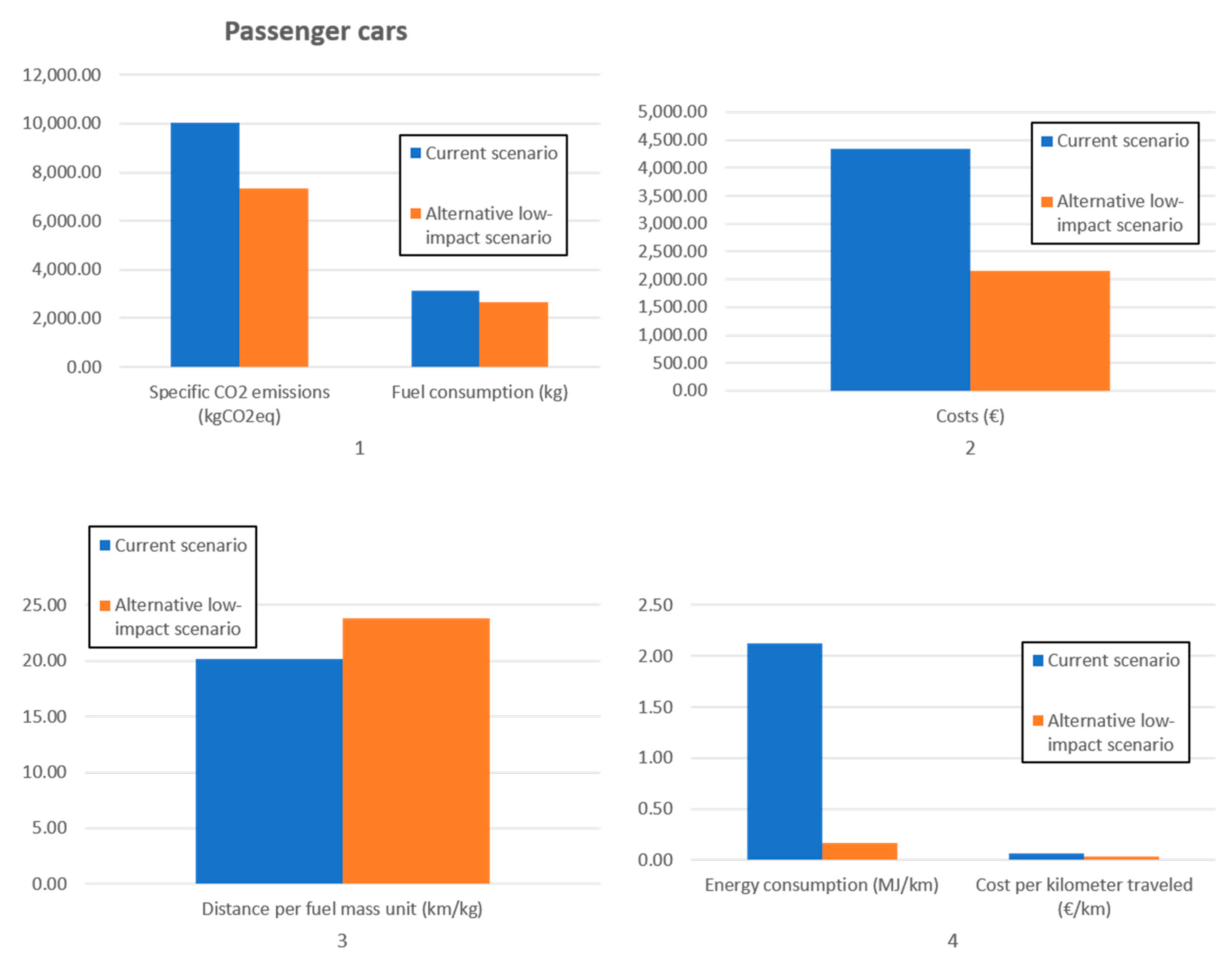
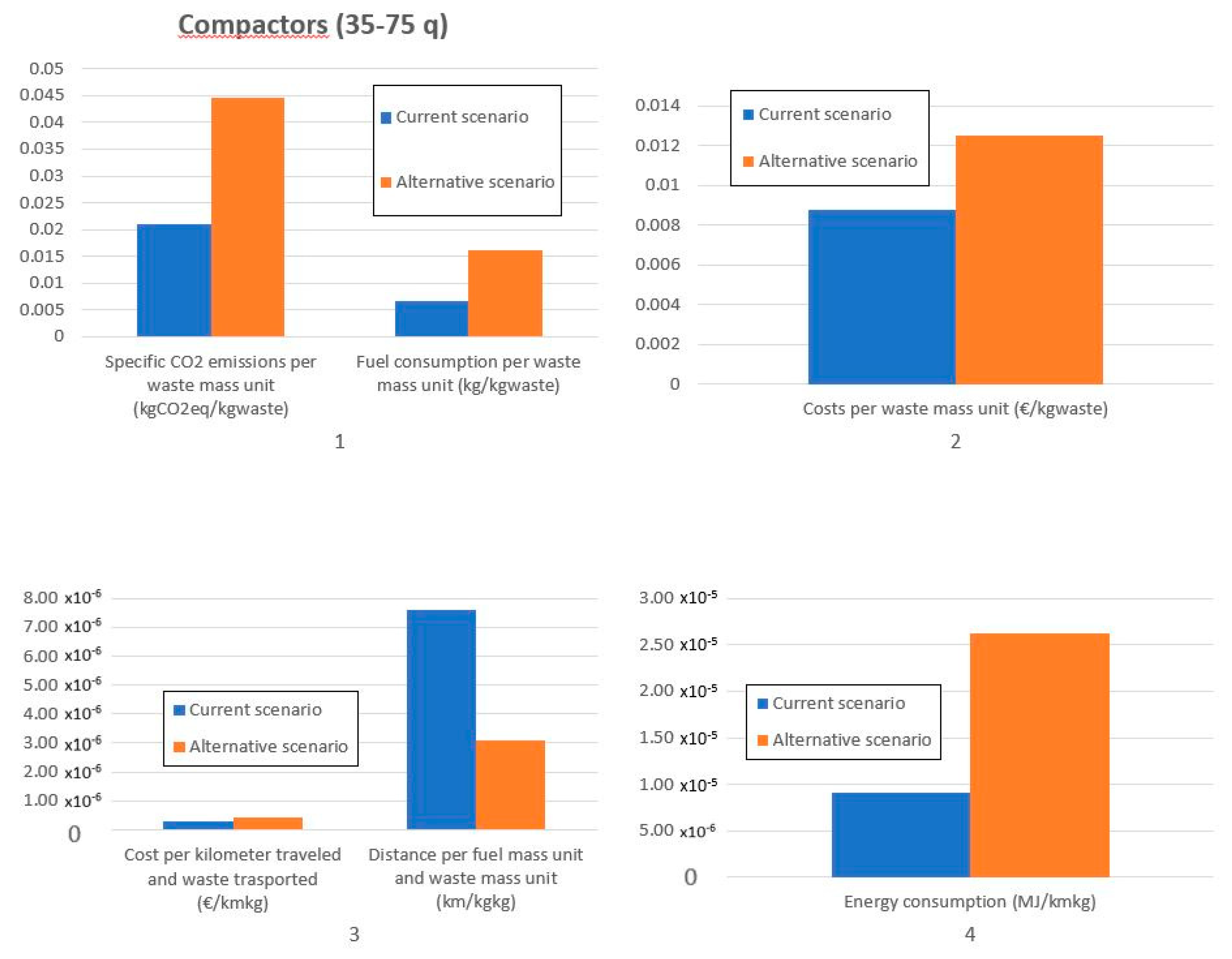

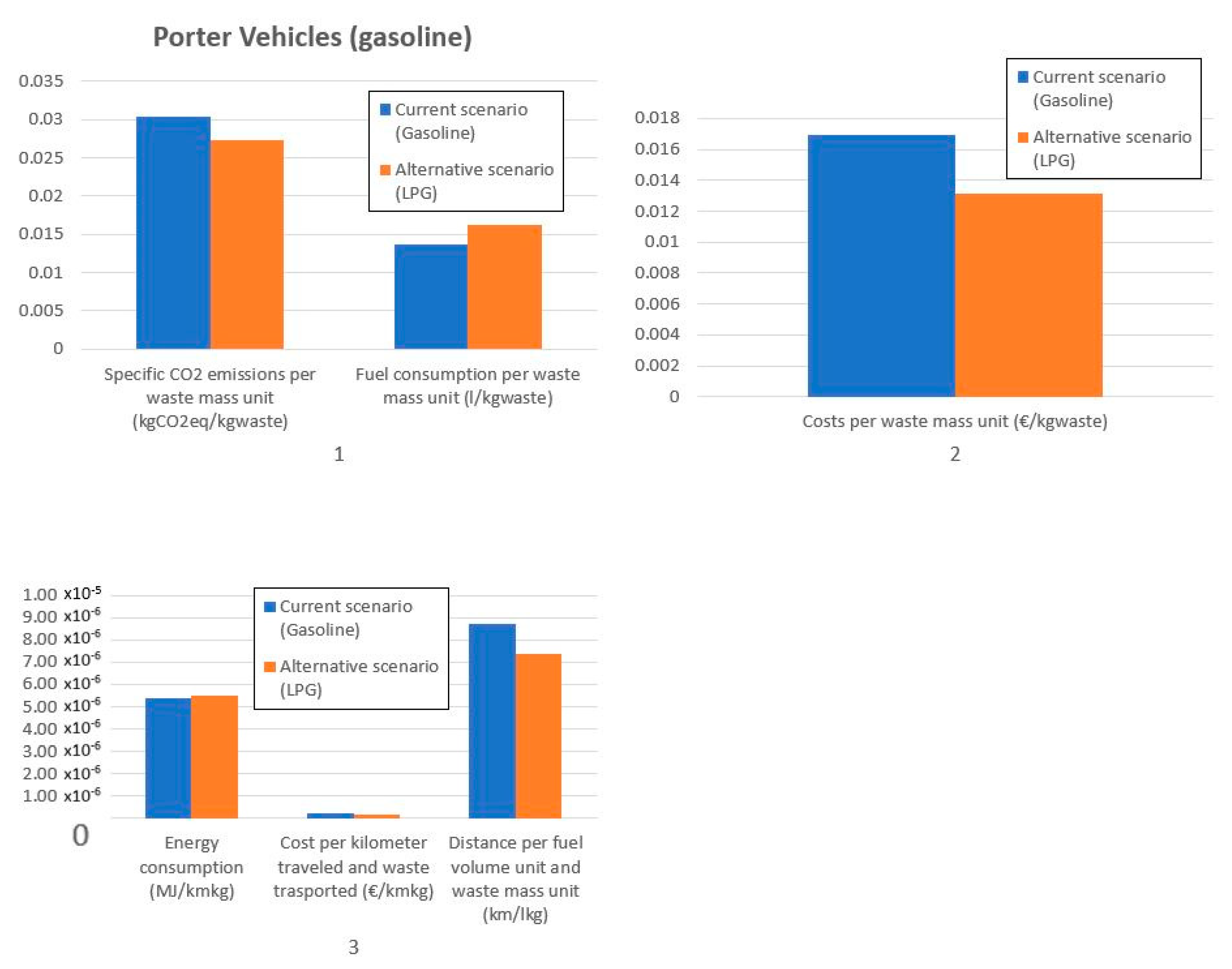
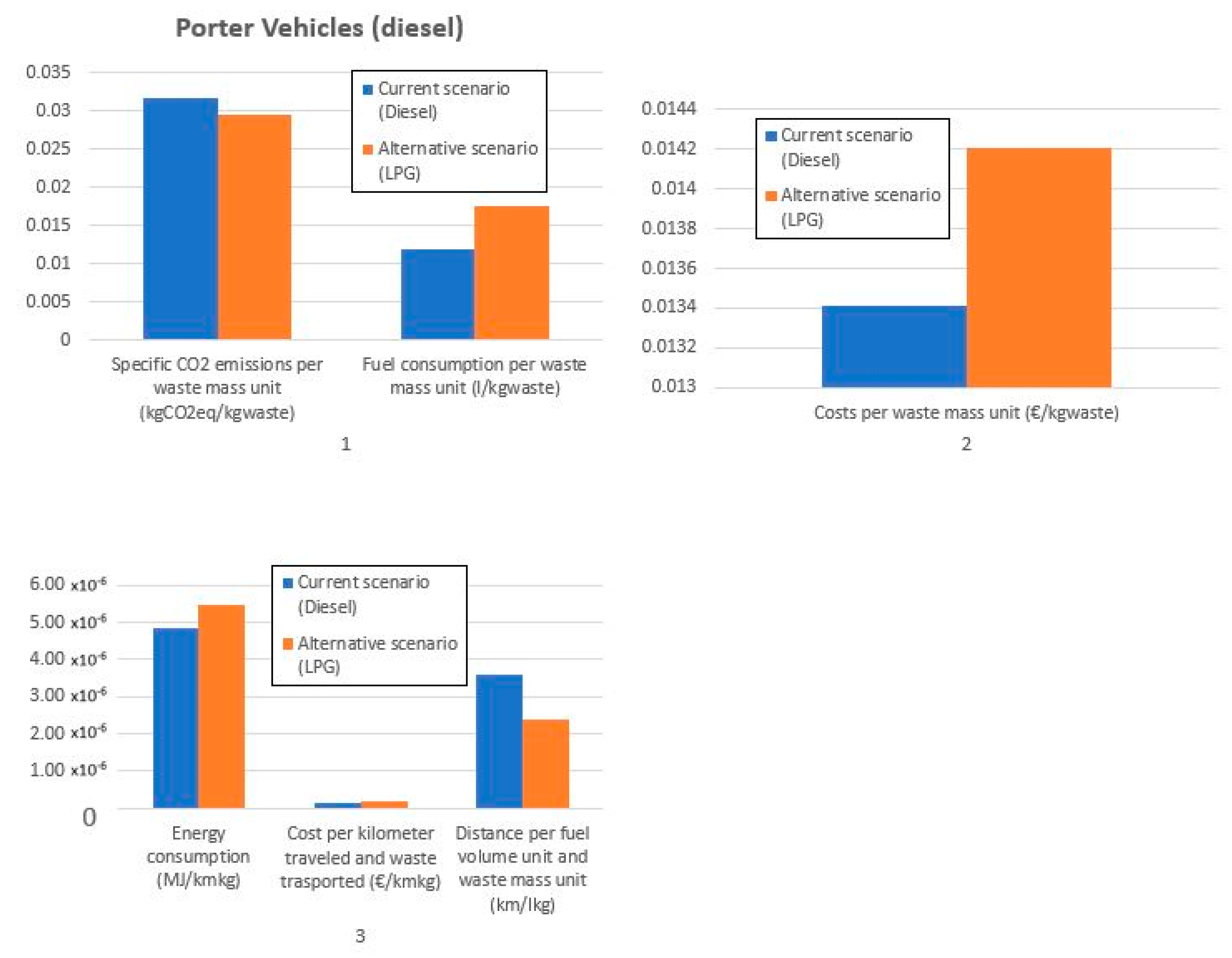
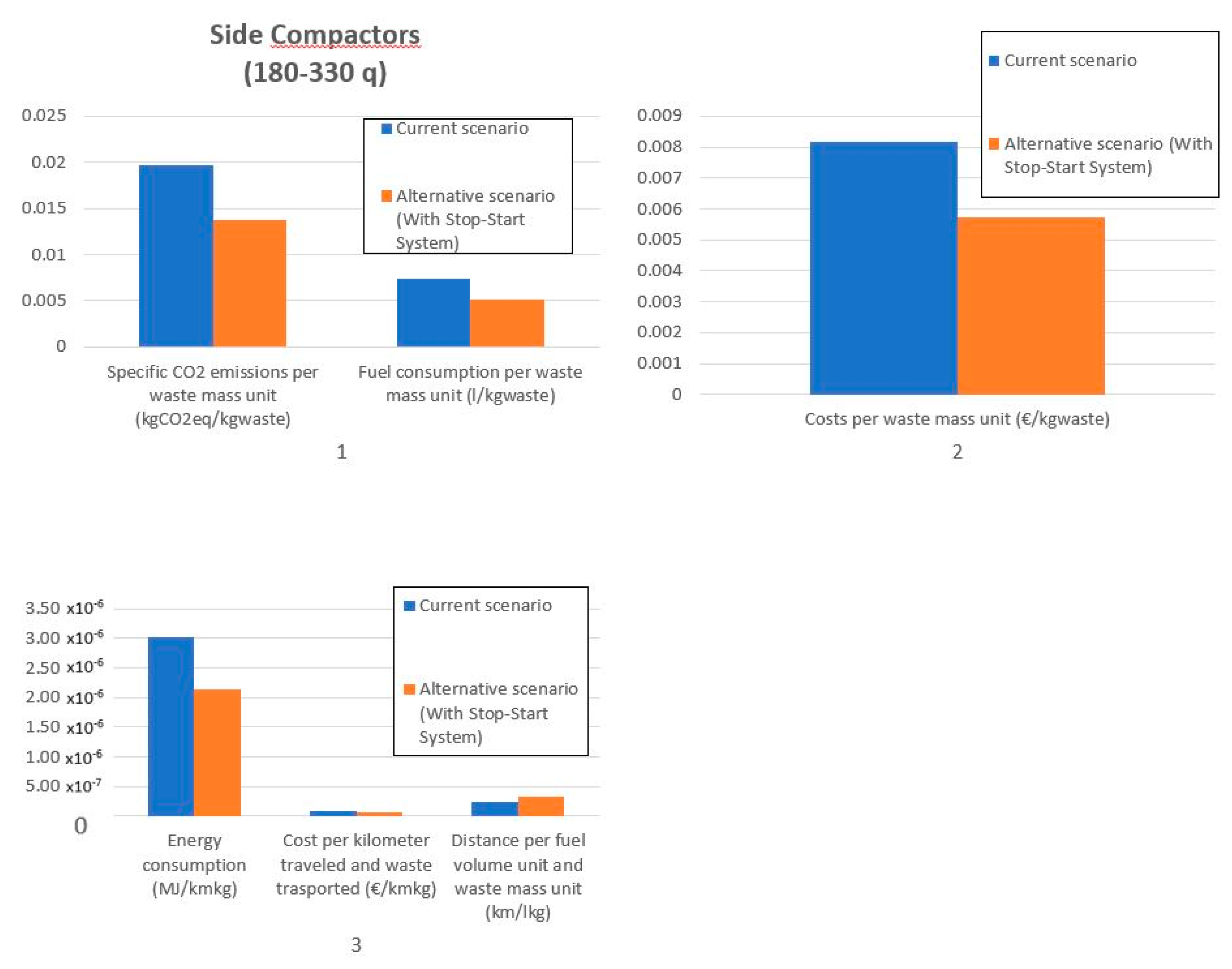
| Category | Fuel | Number of Vehicles | Vehicles with Refueling Only | MSW Transport Vehicles | |
|---|---|---|---|---|---|
| 1 | #N/D | Diesel | 4 | 4 | 0 |
| 2 | Passenger car | Diesel | 11 | 39 | 0 |
| CNG/gasoline | 28 | ||||
| 3 | Truck | Gasoline | 1 | 15 | 0 |
| Diesel | 13 | ||||
| CNG/gasoline | 1 | ||||
| 4 | Tanker (purching, leachate) | Diesel | 5 | 4 | 1 |
| 5 | Side Compactor (180–330 q) | Diesel | 13 | 2 | 11 |
| 6 | Back Compactor (180–330 q) | Diesel | 20 | 6 | 14 |
| 7 | Compactor (35–75 q) | Diesel | 51 | 20 | 34 |
| CNG | 2 | ||||
| CNG/gasoline | 1 | ||||
| 8 | Compactor (80–180 q) | Diesel | 58 | 3 | 64 |
| CNG | 9 | ||||
| 9 | Van | Diesel | 14 | 4 | 10 |
| 10 | Jolly Vehicles | Diesel | 4 | 4 | 0 |
| 11 | Washing machine for waste containers | Diesel | 4 | 3 | 1 |
| 12 | Forklift truck | Diesel | 8 | 8 | 0 |
| 13 | Sprinkler vehicle, beach rake machine | Diesel | 3 | 3 | 0 |
| 14 | Mini hydrostatic drive loaders | Diesel | 1 | 1 | 0 |
| 15 | Wheel loader | Diesel | 4 | 4 | 0 |
| 16 | Tana and Kaelble operating machines, Crawler loaders, Krambo | Diesel | 4 | 4 | 0 |
| 17 | Three-wheeler | Gasoline | 34 | 20 | 14 |
| 18 | Skip loader (240–330 q) | Diesel | 19 | 1 | 18 |
| 19 | Skip Loader (35–65 q) | Diesel | 5 | 1 | 4 |
| 20 | Porter Vehicles | Gasoline | 30 | 26 | 67 |
| Diesel | 40 | ||||
| LPG/Gasoline | 23 | ||||
| 21 | Tipper truck | Diesel | 20 | 4 | 16 |
| 22 | Semitrailer\Compactor trailer | Diesel | 2 | 2 | 0 |
| 23 | Street sweepers | Diesel | 26 | 11 | 15 |
| 24 | Sweeper on running gear | Diesel | 9 | 2 | 7 |
| 25 | Road tractors | Diesel | 13 | 1 | 12 |
| Total number | 480 | 192 | 288 |
| Categories | Current Scenario | Alternative Scenario | Performance Parameters |
|---|---|---|---|
| Passenger cars | Recorded mileage 11 diesel cars 28 CNG cars | Same mileage as in the current scenario 39 CNG cars | CO2 emissions Fuel consumption Total and specific costs for refueling Energy consumption |
| Compactors (35–75 q) | Recorded mileage Recorded waste amount 51 diesel compactors 3 CNG compactors | Same mileage and waste amount as in the current scenario 54 CNG compactors | CO2 emissions Fuel consumption Total and specific costs for refueling Energy consumption (MJkm−1kg−1 and kmkgfuel−1kgwaste−1) |
| Compactors (80–180 q) | Recorded mileage Recorded waste amount 58 diesel compactors 9 CNG compactors | Same mileage and waste amount as in the current scenario 67 CNG compactors | |
| Compactors (180–330 q) | Recorded mileage Recorded waste amount All diesel compactors | Same mileage and waste amount as in the current scenario All diesel compactors equipped with Stop-Start System | |
| Porter vehicles | Recorded mileage Recorded waste amount 30 gasoline vehicles 40 diesel vehicles 23 LPG vehicles | Same mileage and waste amount as in the current scenario Gasoline/diesel vehicles replaced with LPG vehicles | |
| Three-wheelers | Recorded mileage Recorded waste amount All gasoline vehicles | Same mileage and waste amount as in the current scenario All gasoline vehicles equipped with Stop-Start System |
| Categories | Alternative Scenario | ||
|---|---|---|---|
| Benefits | Disadvantages | Impacts | |
| Passenger cars with CNG/gasoline fuel | −2675 kgCO2eq (−26%) −1.96 MJ km−1 (−91%) −488.7 kg (−15%) −2200 € (−50%) −0.035 € km−1 (−51%) +3.7 km kg−1 (+18%) | Carbon footprint Energy impact Fuel consumption Economic impact Route performance | |
| Compactors (35–75 q) with CNG fuel | +2947 € (+43%) +1.2 × 10−7 € km−1kgwaste−1 (+43%) +18,355 kgCO2eq (+110%) +0.02 kgCO2eq kgwaste−1 (+110%) + 7538 kg (+145%) −4.5 × 10−6 km kg−1kg−1 (−59%) +1.7 × 10−5 MJ km−1kg−1 (+186%) | Economic impact Carbon footprint Fuel consumption Route performance Energy impact | |
| Compactor (80–180 q) with CNG fuel | +385,478 total kgCO2eq (+377%) +0.09 kgCO2eq kgwaste−1 (+377%) +1.7 × 10−5 MJ km−1kg−1 (+550%) +91,578 € (+213%) +2.1 × 10−7 € km−1kgwaste−1 (+213%) +145,610 kg (+456%) −7.2 × 10−7 km kg−1kg−1 (−82%) | Carbon footprint Energy impact Economic impact Fuel consumption Route performance | |
| Porter Vehicles gasoline supposed with LPG fuel | −2470 total kgCO2eq (−10%) −0.003 kgCO2eq kgwaste−1 (−10%) −3145 € (−23%) −4.7 × 10−8 € km−1kgwaste−1 (−23%) | +2042 L (+18%) +9.7 × 10−8 MJ km−1kg−1 (+2%) −1.3 × 10−6 km L−1kg−1 (−15%) | Carbon footprint Economic impact Fuel consumption Energy impact Route performance |
| Porter Vehicles diesel supposed with LPG fuel | −3049.4 total kgCO2eq (−7%) −0.002 kgCO2eq kgwaste−1 (−7%) | +8341 L (+49%) +1153 € (+6%) +9.2 × 10−9 € km−1kgwaste−1 (+6%) +6.5 × 10−7 MJ km−1kg−1 (+13%) −1.2 × 10−6 km L−1kg−1 (−33%) | Carbon footprint Fuel consumption Economic impact Energy impact Route performance |
| Side Compactor (180–330 q) with Stop-Start System | −38,332 total kgCO2eq (−28%) −0.002 kgCO2eq kgwaste−1 (−28%) −8.8 × 10−7 MJ km−1kg−1 (−29%) −14,262 L (−28%) −15,903 € (−28%) −2.7 × 10−8 € km−1kgwaste−1 (−28%) +9 × 10−8 km kg−1L−1 (+37%) | Carbon footprint Energy impact Fuel consumption Economic impact Route performance | |
| Three-Wheelers with Stop-Start System | −3 × 10−5 MJ km−1kg−1 (−15%) | +722 total kgCO2eq (+77%) +0.05 kgCO2eq kgwaste−1 (+77%) +328 L (+77%) +404 € (+77%) −5 × 10−4 km kg−1L−1 (−73%) | Energy impact Carbon footprint Fuel consumption Economic impact Route performance |
© 2020 by the authors. Licensee MDPI, Basel, Switzerland. This article is an open access article distributed under the terms and conditions of the Creative Commons Attribution (CC BY) license (http://creativecommons.org/licenses/by/4.0/).
Share and Cite
Quintili, A.; Castellani, B. The Energy and Carbon Footprint of an Urban Waste Collection Fleet: A Case Study in Central Italy. Recycling 2020, 5, 25. https://doi.org/10.3390/recycling5040025
Quintili A, Castellani B. The Energy and Carbon Footprint of an Urban Waste Collection Fleet: A Case Study in Central Italy. Recycling. 2020; 5(4):25. https://doi.org/10.3390/recycling5040025
Chicago/Turabian StyleQuintili, Alessio, and Beatrice Castellani. 2020. "The Energy and Carbon Footprint of an Urban Waste Collection Fleet: A Case Study in Central Italy" Recycling 5, no. 4: 25. https://doi.org/10.3390/recycling5040025
APA StyleQuintili, A., & Castellani, B. (2020). The Energy and Carbon Footprint of an Urban Waste Collection Fleet: A Case Study in Central Italy. Recycling, 5(4), 25. https://doi.org/10.3390/recycling5040025






